Cranking the green stuff
When walleyes lurk among the weeds, casting and cranking a baitfish-imitating plug is an outstanding way to lure them out
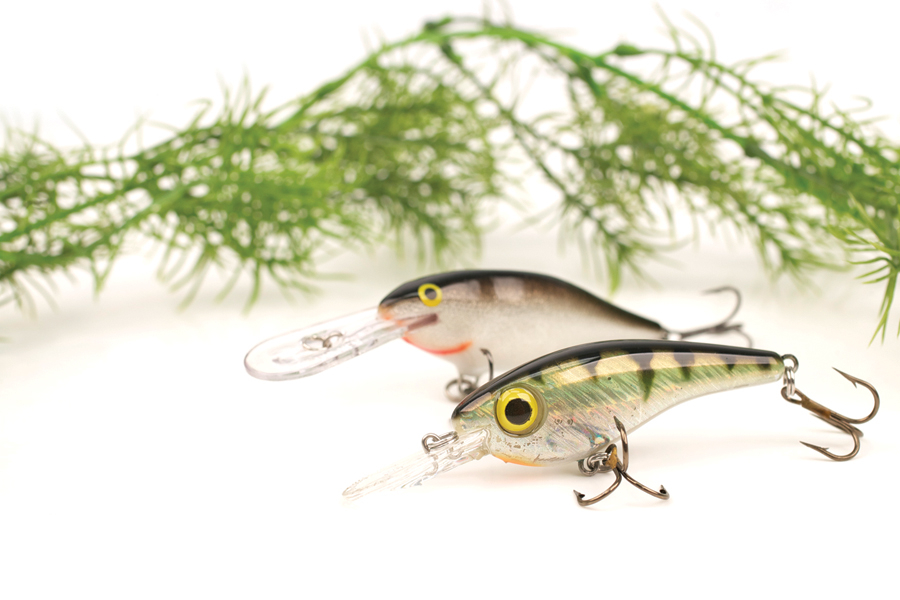
Editor’s note: This article first appeared in Walleye Magazine.
——————————————-
Here’s a simple walleye-fishing fact for you: Walleyes love weeds.
Here’s another: Walleyes in weeds love crankbaits.
At least, that’s the word from Jason Feldner of Minnewaukan, N.D., and Kevin McQuoid of Isle, Minn. And both should know. Each has won National Guard FLW Walleye Tour events in the past two years tossing cranks where few others would dare. Feldner used crankbaits to supplement his pattern when he won the July 2010 National Guard FLW Walleye Tour Western Division event on his home waters of Devils Lake. For McQuoid, cranking was his sole pattern when he claimed victory a year earlier at Lake Winnebago.
Two different anglers, from two different states, on two different bodies of water. Yet the results were the same.
It just goes to show that crankbaits might not have been designed to fish around weeds, but they sure are effective in vegetation when applied properly. It requires careful evaluation of a lake’s weedbeds and a planned approach. But get it right, and it can all add up to victory on any lake.
Walleye salad
Walleyes will use weeds throughout most of the year, seeking them out during the postspawn and residing there until late fall. Thus the crankbait technique is always an option for Feldner and McQuoid. The key for both of them is finding the right weeds.
“I look for the cabbage-type stuff,” McQuoid says. “It seems to hold more perch and other forage, and more walleyes.”
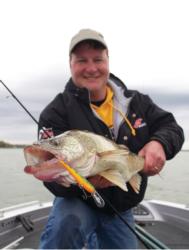
The term “cabbage” gets used to describe various species of vegetation, with the most notable feature for all of them being their broad, soft leaves off the main stem, often from the base all the way to the tip of the plant. These leaves make them ideal for walleyes and for the crankbait tactic.
Typically, cabbage beds are less dense than those of other species of aquatic plants. This allows predator fish to move through them more easily, while still lurking out of sight from prey. From an angling approach, the leaves don’t cling to the hooks of a crankbait like coontail or milfoil, and there’s more space within the bed to fish a crankbait. That’s not to say the technique won’t work with other weed species; it’s just easiest with cabbage.
Cabbage usually grows in relatively shallow water, often along banks or over sandy points or humps. Most cabbage shows up early in the season and is barely visible at first, but it grows quickly as the days lengthen and the water warms. Some varieties reach the surface and then die back and sink late in the summer. Other kinds of cabbage remain submerged and are around throughout the open-water season.
Better cabbage
Sure, cabbage is the favorite type of weed for McQuoid and Feldner to target specifically with a crankbait. But in lakes full of cabbage, a lot of the green has to be eliminated before the best areas are located.
The first prerequisite is walleye forage. Healthy cabbage harbors bait, so often greener is better. But most importantly, look for weeds that show some signs of life such as baitfish rippling, predator fish swirling – anything.
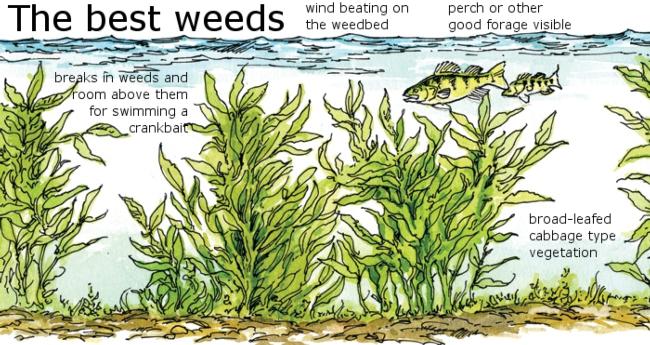
Other factors to consider are the location of the lake and the bottom content. Key on weed flats that get the most sun exposure. The sun warms the water, and warmer water is almost always more productive, even if it’s only a few degrees different from elsewhere in the lake.
“Little areas that have a harder bottom beneath the cabbage also tend to be better,” Feldner adds.
Meanwhile, McQuoid prefers broad-leaf cabbage that doesn’t grow all the way to the surface. And the more holes and edges that he can work with his crankbait, the better.
Wonderful wind
“Location, location, location” is the catchphrase for realtors. For Feldner, however, it’s “wind, wind, wind,” because a blowing wind creates the best locations for catching fish.
“I look for the most wind-beaten cabbage weeds on the lake, and those are the areas I fish,” he notes.
The wind serves the double duty of stirring up silt and breaking up the water’s surface, and both results can cause walleyes to feed more actively. Even a small chop is enough to help the bite.
Another key that helps the crankbait bite is water color. A bit of color in the water decreases light penetration and can prompt the fish to stray shallower and to feed atop the weeds. It’s an ideal scenario for fishing a crankbait over the cabbage, rather than having to use some other technique that must be applied farther down into the weeds when walleyes are in the thick of things.
“Ideally, I like water color with visibility that lets me just see the bottom in about 3 feet of water,” McQuoid says.
Casting positions
The position of the boat in relation to a weedbed is something that should change throughout the season as weed growth changes.
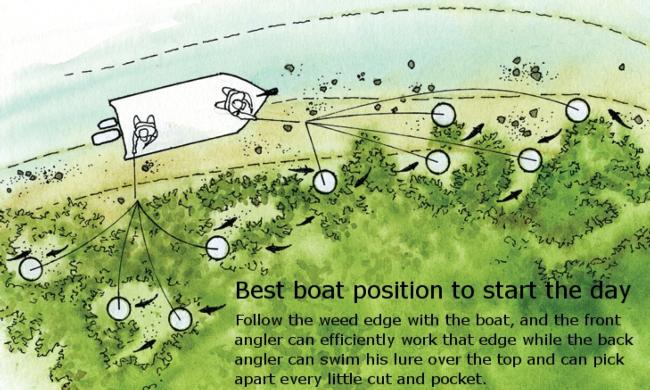
Feldner’s seasonal approach: Early in the season, when the cabbage is just beginning to grow, he positions the boat directly over the cabbage, near the deepest edge, and casts to shallower water. As the season and the vegetation’s growth progress, he’s forced to move the boat more toward the edge and aim for visible gaps. He also has to hold his rod high to keep the lure shallower in the water column. Eventually, when he can no longer fish a crankbait over the top, Feldner will resort to trolling along the edges.
McQuoid’s default boat position for cranking weeds is right along the deep edge. From that position he has two options: cast parallel to the edge or cast over the top of the vegetation. He can alternate each approach until one proves more productive.
There is another major advantage of following the outside edge of the weeds that occurs when there are two anglers in the boat. The fisherman in the front can cast parallel to the edge and continually fish new water; the back angler can cast across the weed flat and fish over the vegetation, picking apart every little pocket or hole. Covering two zones at once can shorten the fish-finding process significantly.
The presentation
“It’s different every day,” says Feldner about his crankbait presentations. “You have to figure how they want it, so I change things up a lot early in the day.”
Feldner almost always starts by casting as far up over the weeds as possible and cranking down to the weed tops, using his reeling speed and rod height so he barely hits the vegetation with his lure. Early in the season, when the vegetation first starts growing, it sometimes takes more aggressive cranking and a low rod tip to get a lure deep enough to attract the walleyes’ attention. At the opposite end of the spectrum, vegetation that is growing almost to the surface or that is even topping out in spots calls for a slower, more careful presentation, keeping the rod high, threading the needle a bit to work around some grass, and pausing the retrieve when the lure hits the vegetation. This is key.
The pause allows the lure to float up and out of the cover, but it also presents a prime opportunity for a strike. Then, to clear the crankbait of the weeds, Feldner snaps the rod tip. If a fish doesn’t bite on the pause, it often will on the snap. Some days it takes an occasional erratic jerk to prompt strikes from fish that are interested but won’t quite commit. On other days, a pause will trigger strikes, but a jerk will send the same fish scampering for thicker cover.
How walleyes react on any given day is unpredictable, but the process of finding out is what makes fishing the sport that it is.
Calm considerations
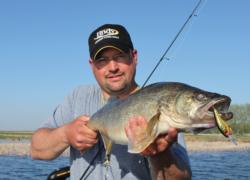 Wind is good; calm is bad. But just because the wind doesn’t blow doesn’t mean you can’t get bit with a crankbait in the weeds.
Wind is good; calm is bad. But just because the wind doesn’t blow doesn’t mean you can’t get bit with a crankbait in the weeds.
Take Jason Feldner’s National Guard FLW Walleye Tour win at Devils Lake in 2010. His primary tournament technique was to pull spinners along the edge of weeds, which often is the way he fishes during the second half of July, when the weeds have grown most of the way to the surface. During practice for the Devils Lake event, however, Feldner had been spotting walleyes on calm days near the tops of the weeds, within a foot and a half of the surface.
“There must have been young-of-the-year walleyes, perch or some other type of forage up high,” Feldner says. “For whatever reason, the fish were only there on calm days.”
The fish were high in the water column and too far into the cabbage patch to troll spinners or crankbaits through them, and turning the boat into the weeds even slightly would spook the fish. Feldner figured out, however, that those fish could be caught by casting a crankbait, as long as the rod was kept high throughout the retrieve to keep the lure from getting buried in the vegetation.
During the tournament, Feldner’s co-angler would stand at the bow and cast the crankbait over the top of the vegetation as Feldner worked the boat right along the edges, pulling spinners. The crankbait ended up producing several important fish during the event.
The crankbaits
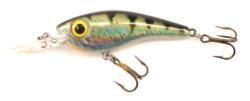 Jason Feldner – Lindy Shadling
Jason Feldner – Lindy Shadling
Favorite size: No. 5 (2 7/16 inches) for most weedbed casting applications; No. 7 (2 7/8 inches) for digging a little deeper or to match large forage
Favorite color: yellow perch
Cranking depth: 5 to 6 feet
Action: tight wiggling and fast diving
Why he likes it: “What it says on the package is exactly what you get with the colors, whether it’s a perch, a tullibee or a bluegill. They really hit it right with the hues that are reflected with the various kinds of baitfish.”
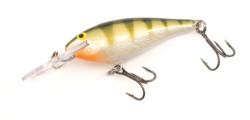 Kevin McQuoid – Rapala Shad Rap
Kevin McQuoid – Rapala Shad Rap
Favorite size: No. 5 (2 inches, 3/16 ounce)
Favorite color: perch
Cranking depth: 4 to 9 feet
Action: tight wiggle with a bit of a roll; buoyancy helps it slide over weeds
Why he likes it: “Its shape and size are just a perfect imitation for a perch, which is one of the biggest baitfish in almost all the waters we fish. It’s my go-to crankbait for fishing weeds.”
Reach out over pressured waters
Think cranking for weed walleyes is only a tactic for catching aggressive fish? Think again.
When Kevin McQuoid was preparing for the 2009 Lake Winnebago National Guard FLW Walleye Tour event, which he would eventually win, he witnessed a lot of anglers trolling and working the edges of the lake’s weedbeds. Figuring walleyes would try and get away from the fishing pressure by moving farther into the weeds, McQuoid began casting crankbaits across weed tops that were too shallow to fish with a trolling strategy.
He started the tournament working in about 7 feet of water, casting over fully submerged vegetation. However, the fishing pressure throughout the event caused the fish to move even shallower, into only a few feet of water. He moved shallow with them and finessed his crankbait through the tops of the weeds.